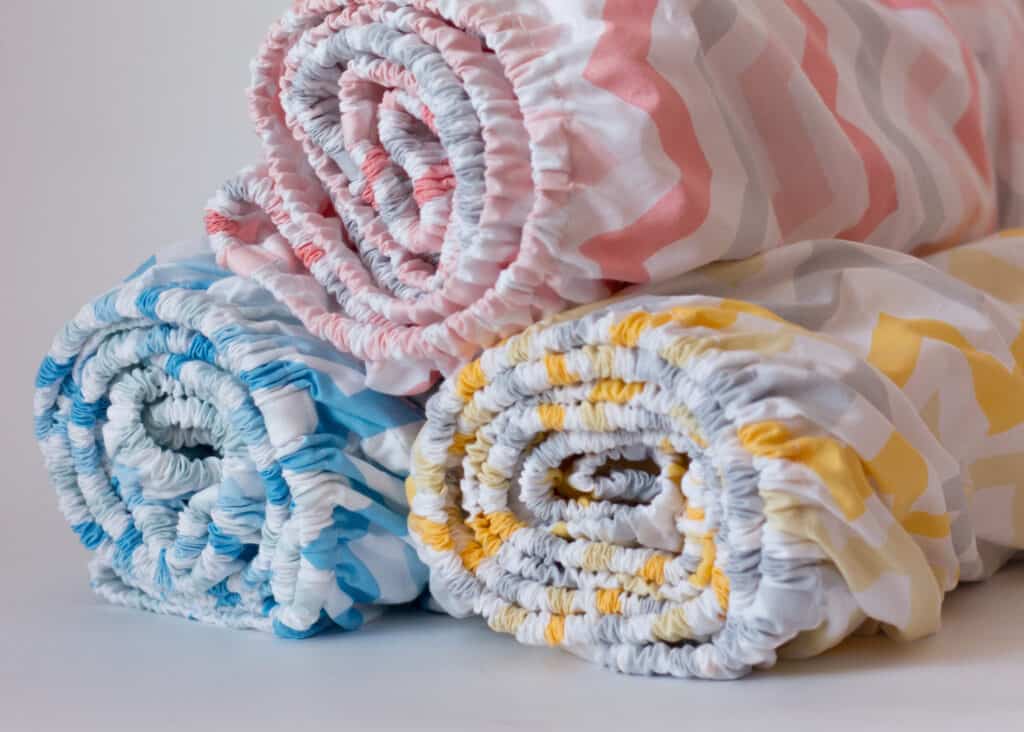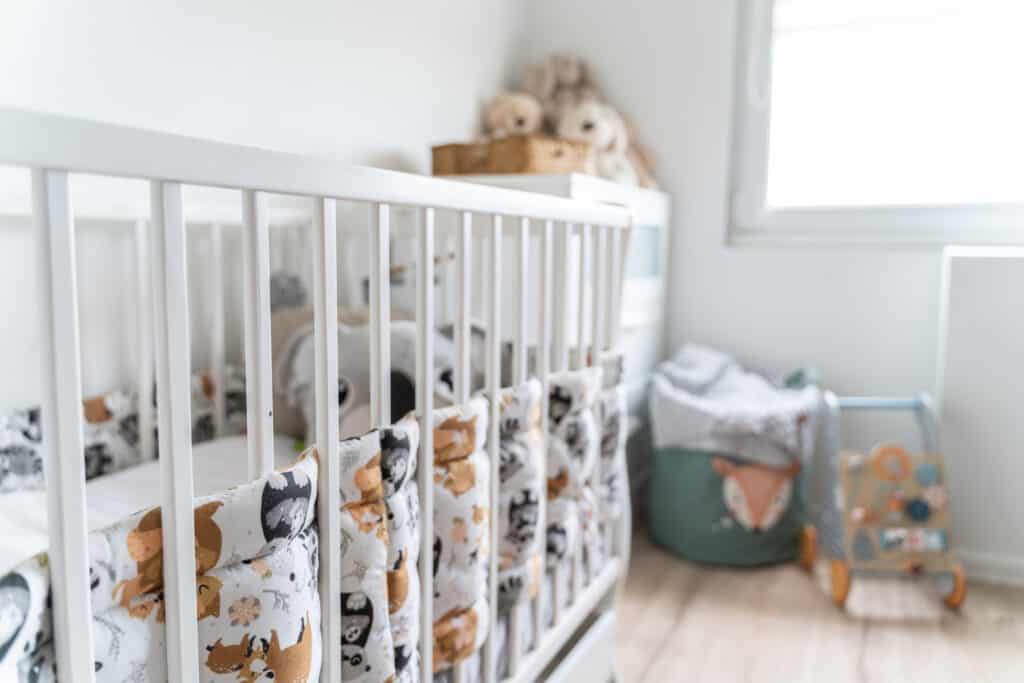Welcoming a newborn can be an exhilarating yet stressful experience. From ensuring they have the right formula to having enough diapers, preparing for a baby requires a lot of planning. The last thing you need is a last-minute panic about the number of crib sheets you need.
Ideally, you want at least three or four crib sheets on hand so you can change them often. Having one or two clean sheets ready to go enables you to have one unwashed and another on use. More than four gives you more buffer between changing and washing.
Don’t be alarmed if you think that’s a lot of crib sheets to buy. Keep reading to discover why you need so many crib sheets for your baby.

What Is a Crib Sheet and When Should You Use It?
Crib sheets are exactly what the name suggests: they’re sheets for your baby’s crib. They work exactly like a bed sheet: they wrap around the crib mattress to provide a smooth and comfortable surface for the baby.
If you’re planning to leave your baby in a crib, you should definitely use a soft, breathable, fitted crib sheet.
Doing so ensures the baby is comfortable and is not at risk of overheating or suffocating. A smooth surface also helps their skin stay rash-free.
Don’t have any crib sheets available? Used bed sheets will also work if you tuck the ends securely underneath the crib mattress. Make sure it has no strong detergent fragrances that could irritate the baby’s skin.
Lastly, avoid having pillows or extra blankets in your baby’s crib. Keep their surroundings clean and simple: just a crib sheet and nothing else. One of the leading causes of Sudden Infant Death Syndrome, or SIDS, are poor bedding and extra objects in their crib.
Health Benefits of Using a Crib Sheet
Buying a separate crib sheet for your baby might seem unnecessary. Babies outgrow their clothes quickly, so wouldn’t they outgrow their crib after a few months as well?
As it turns out, using a dedicated crib sheet instead of whatever you can put together is safer and healthier for your baby. Crib sheets are supposed to be simple, so they don’t irritate your baby’s skin or suffocate them.
Avoid using detergent with strong scents and fabric softeners when washing a crib sheet. Those fragrances are usually too strong on a baby’s delicate skin, which could result in irritation or rashes. And we all know how much a baby cries whenever they have a rash.
Remember: all babies care about is whether they can sleep and eat comfortably. As long as your crib sheet lets them sleep comfortably, everything will be just fine.
Related: Crib Weight Limits and Safety Guidelines
How To Use a Crib Sheet
If you have a fitted crib sheet, you must align the sheet’s corners with the mattress corners. Drape the sheet over the mattress and tuck the end parts of the sheet underneath to hold it in place. Take a few seconds to smooth the surface and secure the sheet.
Is your crib mattress too snug within the enclosure, making it difficult to remove and replace the sheet? Consider standing the mattress up on the crib so you can access the corners easily. Put the clean crib sheet the same way, then put the mattress back down once you’re finished.
Some parents try to save time by fitting multiple sheets on the mattress, with waterproof pads in between. That way, all you have to do is remove the soiled crib sheet and spent pads to reveal another layer of clean sheets.

How Many Bed Sheets Do You Need for a Newborn?
A minimum of three bed sheets for newborn babies should get you through the next few months. Having more gives you some breathing room in between washes, as you won’t be rushing to get them all cleaned as soon as possible.
If you can only afford three, that’s fine too. Make sure you always have a reserve on hand while one is getting washed and another is being used. There’s nothing more stressful than trying to wash your baby’s sheets quickly because you’ve run out of clean ones.
Remember that you can also use regular bedsheets on their cribs, as long as you can ensure they’ll be wrapping the mattress snugly. The last thing you want is your baby to get tangled with loosely-fitted sheets and suffocate.
How Often Should I Change Crib Sheets?
How often you change crib sheets depends on how many “incidents” happen with your baby. Do they drool and spit up a lot? Do they always have leaks through their diapers or pee while you’re changing their diapers?
If so, you’ll need to change the crib sheet immediately. You should never keep a soiled sheet on the mattress as it will create a foul odor and irritate your baby’s skin. Think of it this way: if you wouldn’t sleep on a bed with drool or pee, don’t let your baby sleep on one, either.
On the other hand, if your baby is relatively calm and is generally content with themselves, changing the sheet weekly should suffice. You don’t want your baby to lay on an accumulation of dead skin cells, drool, and dust from around the house.
Related: Guide To Washing Baby Clothes and Fabrics
Tips on Buying Crib Sheets
Like how we have thread counts and thread material to consider when buying our bedsheets, we also need to consider a few things when purchasing crib sheets. Here are some of them:
- Purchase a fitted crib sheet. You want it to be as snug as possible when in use. That way, the surface will be smooth and won’t accidentally smother your baby.
- Pick a sheet made with 100 percent cotton or bamboo. Cotton is breathable and soft, while bamboo is very smooth. Both ensure your child won’t overheat while sleeping, and the lack of synthetic materials ensures their skin won’t get any reactions.
- Bamboo fibers are your best bet if you’re worried about stains and want to keep the crib sheets pristine. They resist stains well and are easier to wash if it seeps through.
- Pick sheets with fun designs that still enable you to observe for potential stains. Your baby is constantly learning from their environment, so having a visually stimulating crib sheet can help their development and curiosity.
- See if you can buy a cotton or bamboo crib sheet that is already pre-shrunk. Those materials tend to shrink over several washes. The last thing you need is for your crib sheet to shrink significantly and become unusable after the first wash.
A crib sheet’s simplicity is the exact opposite of what adults use. We, as adults, care about thread counts on our sheets and the thickness of our comforters. But for crib sheets: not so much.
Final Thoughts
Always remember that infants spend the majority of their days asleep. After all, they need that time to continue growing and developing. Crib sheets help ensure they have a comfortable, safe, and uninterrupted sleep.
That’s why crib sheets should always be on your list when planning for your newborn’s arrival. They may not be as urgent as clothes and diapers, but they can be a game-changer for your baby’s sleep. Just because crib sheets are underrated doesn’t mean you should ignore them.

